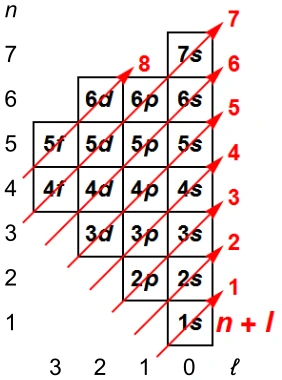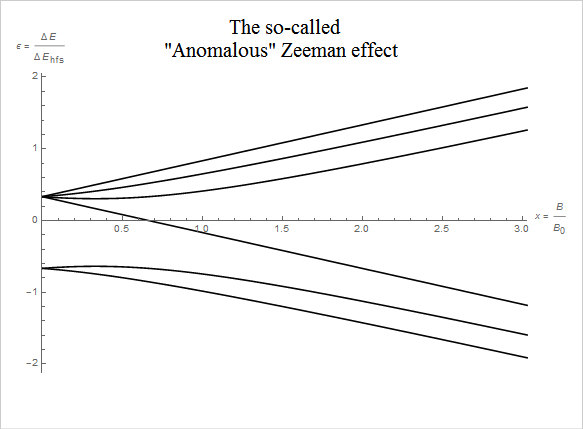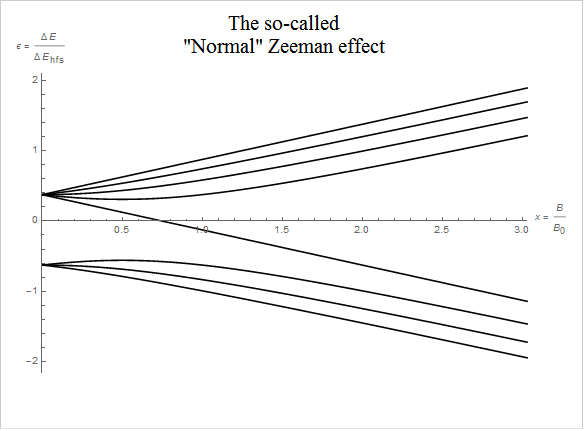|
|
|
Acceptor
(P-type)
|
Semi-
conductor
|
Donor
(N-type)
|
Note that due to sp3 hybridization the
end wraps back around to the beginning ↘
|
|
| Strong magnetic field
|
|
-1⁄2
|
-3⁄2
|
-3⁄2
|
-1⁄2
|
1⁄2
|
3⁄2
|
|
3⁄2
|
1⁄2
|
mℓ
|
|
|
|
"normal" Zeeman effect → sp3 hybridization? →
|
|
-1⁄2
|
-1⁄2
|
1⁄2
|
1⁄2
|
1⁄2
|
1⁄2
|
|
-1⁄2
|
-1⁄2
|
ms
|
|
|
Weak magnetic field
|
|
-1
|
-2
|
-1
|
0
|
1
|
2
|
|
1
|
0
|
mj
|
|
|
mℓ + ms = mj
|
Note the one electron that
switches from orange to yellow
|
| ℓ
|
3
|
|
↓
|
|
|
2
|
|
|
1
|
|
|
0
|
|
ℓ
|
| mℓ
|
3
|
2
|
1
|
0
|
-1
|
-2
|
-3
|
-3
|
-2
|
-1
|
0
|
1
|
2
|
3
|
|
2
|
1
|
0
|
-1
|
-2
|
-2
|
-1
|
0
|
1
|
2
|
|
1
|
0
|
-1
|
-1
|
0
|
1
|
|
0
|
0
|
mℓ
|
| ms
|
-1⁄2
|
-1⁄2
|
-1⁄2
|
-1⁄2
|
-1⁄2
|
-1⁄2
|
-1⁄2
|
1⁄2
|
1⁄2
|
1⁄2
|
1⁄2
|
1⁄2
|
1⁄2
|
1⁄2
|
|
-1⁄2
|
-1⁄2
|
-1⁄2
|
-1⁄2
|
-1⁄2
|
1⁄2
|
1⁄2
|
1⁄2
|
1⁄2
|
1⁄2
|
|
-1⁄2
|
-1⁄2
|
-1⁄2
|
1⁄2
|
1⁄2
|
1⁄2
|
|
-1⁄2
|
1⁄2
|
ms
|
| mj
|
5⁄2
|
3⁄2
|
1⁄2
|
-1⁄2
|
-3⁄2
|
-5⁄2
|
-7⁄2
|
-5⁄2
|
-3⁄2
|
-1⁄2
|
1⁄2
|
3⁄2
|
5⁄2
|
7⁄2
|
|
3⁄2
|
1⁄2
|
-1⁄2
|
-3⁄2
|
-5⁄2
|
-3⁄2
|
-1⁄2
|
1⁄2
|
3⁄2
|
5⁄2
|
|
1⁄2
|
-1⁄2
|
-3⁄2
|
-1⁄2
|
1⁄2
|
3⁄2
|
|
-1⁄2
|
1⁄2
|
mj
|
| J
|
5⁄2
|
|
7⁄2
|
|
|
3⁄2
|
|
5⁄2
|
|
|
1⁄2
|
|
3⁄2
|
|
|
1⁄2
|
|
J
|
|
|
f 5⁄2
|
|
f 7⁄2
|
|
|
d 3⁄2
|
|
d 5⁄2
|
|
|
p 1⁄2
|
|
p 3⁄2
|
|
|
s 1⁄2
|
|
|
|
|
1
|
2
|
3
|
4
|
5
|
6
|
7
|
8
|
9
|
10
|
11
|
12
|
13
|
14
|
|
1
|
2
|
3
|
4
|
5
|
6
|
7
|
8
|
9
|
10
|
|
1
|
2
|
3
|
4
|
5
|
6
|
|
1
|
2
|
|
| 8
|
| 89
|
| Ac
|
| 227.0278
|
1.8829 Å
- fc-c
- 0.74
|
|
| 90
|
| Th
|
| 232.0377
|
α:1.8027 Å
- fc-c
- 0.74
|
β:1.7848 Å
- bc-c
- 0.68
|
|
| 91
|
| Pa
|
| 231.0359
|
α:1.6112 Å
- bc-t(0.82)
- 0.696
|
|
| 92
|
| U
|
| 238.0289
|
α:1.1358 Å
- bc-ortho
- 0.293
|
β:1.4457 Å
- unknown
- 0.547
|
γ:1.5304 Å
- bc-c
- 0.68
|
|
| 93
|
| Np
|
| 237.0482
|
α:1.4918 Å
- bc-ortho
- 0.717
|
β:1.3882 Å
- unknown
- 0.547
|
γ:1.5278 Å
- bc-c
- 0.68
|
|
| 94
|
| Pu
|
| 244.0642
|
α:0.9662 Å
- mono(102°)
- 0.183
|
β:1.3733 Å
- ec-mono
- 0.47
|
γ:1.5951 Å
- fc-ortho
- 0.357
|
δ:1.6556 Å
- fc-c
- 0.74
|
δ':1.6366 Å
- bc-t(1.33)
- 0.72
|
ε:1.59 Å
- bc-c
- 0.68
|
|
| 95
|
| Am
|
| 243
|
α:1.7393 Å
- dh-cp
- 0.74
|
|
| 96
|
| Cm
|
| 247
|
α:1.7409 Å
- dh-cp
- 0.74
|
β:1.7464 Å
- fc-c
- 0.74
|
|
| 97
|
| Bk
|
| 247
|
α:1.7037 Å
- dh-cp
- 0.74
|
|
| 98
|
| Cf
|
| 251
|
α:1.7014 Å
- dh-cp
- 0.74
|
|
| 99
|
| Es
|
| 252
|
2.036 Å
- fc-c
- 0.74
|
|
|
|
|
|
|
|
|
|
|
|
|
|
|
|
|
|
|
|
|
|
|
|
Alkali
metals
|
Alkaline
earth
metals
|
8
|
| 7
|
| 57
|
| La
|
| 138.9055
|
α:1.8824 Å
- dh-cp
- 0.74
|
|
| 58
|
| Ce
|
| 140.116
|
β:1.8373 Å
- dh-cp
- 0.74
|
γ:1.8296 Å
- fc-c
- 0.74
|
|
| 59
|
| Pr
|
| 140.9077
|
α:1.8331 Å
- dh-cp
- 0.74
|
|
| 60
|
| Nd
|
| 144.242
|
α:1.8266 Å
- dh-cp
- 0.74
|
|
| 61
|
| Pm
|
| 144.9128
|
α:1.8164 Å
- dh-cp
- 0.74
|
|
| 62
|
| Sm
|
| 150.36
|
α:1.8075 Å
- tri-cp
- 0.74
|
|
| 63
|
| Eu
|
| 151.964
|
1.9893 Å
- bc-c
- 0.68
|
|
| 64
|
| Gd
|
| 157.25
|
1.8072 Å
- h-cp
- 0.74
|
|
| 65
|
| Tb
|
| 158.9254
|
1.7863 Å
- h-cp
- 0.74
|
|
| 66
|
| Dy
|
| 162.5
|
1.7795 Å
- h-cp
- 0.74
|
|
| 67
|
| Ho
|
| 164.9303
|
1.7704 Å
- h-cp
- 0.74
|
|
| 68
|
| Er
|
| 167.259
|
1.7613 Å
- h-cp
- 0.74
|
|
| 69
|
| Tm
|
| 168.9342
|
1.7508 Å
- h-cp
- 0.74
|
|
| 70
|
| Yb
|
| 173.054
|
1.9467 Å
- fc-c
- 0.74
|
|
|
| 71
|
| Lu
|
| 174.9668
|
1.7391 Å
- h-cp
- 0.74
|
|
| 72
|
| Hf
|
| 178.49
|
1.5854 Å
- h-cp
- 0.74
|
|
| 73
|
| Ta
|
| 180.9479
|
1.4342 Å
- bc-c
- 0.68
|
|
| 74
|
| W
|
| 183.84
|
1.3744 Å
- bc-c
- 0.68
|
|
| 75
|
| Re
|
| 186.207
|
1.3789 Å
- h-cp
- 0.74
|
|
| 76
|
| Os
|
| 190.23
|
1.3561 Å
- h-cp
- 0.74
|
|
| 77
|
| Ir
|
| 192.217
|
1.3613 Å
- fc-c
- 0.74
|
|
| 78
|
| Pt
|
| 195.084
|
1.3912 Å
- fc-c
- 0.74
|
|
| 79
|
| Au
|
| 196.9666
|
1.446 Å
- fc-c
- 0.74
|
|
| 80
|
| Hg
|
| 200.592
|
α:1.5118 Å
- rhomb(71°)
- 0.608
|
|
|
| 81
|
| Tl
|
| 204.3835
|
1.7209 Å
- h-cp
- 0.74
|
|
| 82
|
| Pb
|
| 207.2
|
1.7552 Å
- fc-c
- 0.74
|
|
| 83
|
| Bi
|
| 208.9804
|
1.8107 Å
- rhomb(57°)
- 0.696
|
|
| 84
|
| Po
|
| 208.9824
|
α:2.382 Å
- fcc+alv
- 0.74
|
|
| 85
|
| At
|
| 209.9871
|
2.1393 Å
- fc-c
- 0.74
|
|
| 86
|
| Rn
|
| 222.0176
|
2.4629 Å
- fc-c
- 0.74
|
|
|
|
| 88
|
| Ra
|
| 226.0254
|
2.2356 Å
- bc-c
- 0.68
|
|
7
|
| 6
|
Actinide
Lanthanide (Rare-earth element)
|
|
| 39
|
| Y
|
| 88.9058
|
1.8056 Å
- h-cp
- 0.74
|
|
| 40
|
| Zr
|
| 91.224
|
1.6071 Å
- h-cp
- 0.74
|
|
| 41
|
| Nb
|
| 92.9064
|
1.4332 Å
- bc-c
- 0.68
|
|
| 42
|
| Mo
|
| 95.95
|
1.3666 Å
- bc-c
- 0.68
|
|
| 43
|
| Tc
|
| 97.9072
|
1.3637 Å
- h-cp
- 0.74
|
|
| 44
|
| Ru
|
| 101.07
|
1.3425 Å
- h-cp
- 0.74
|
|
| 45
|
| Rh
|
| 102.9055
|
1.3486 Å
- fc-c
- 0.74
|
|
| 46
|
| Pd
|
| 106.42
|
1.3794 Å
- fc-c
- 0.74
|
|
| 47
|
| Ag
|
| 107.8682
|
1.4487 Å
- fc-c
- 0.74
|
|
| 48
|
| Cd
|
| 112.414
|
1.567 Å
- h-cp
- 0.74
|
|
|
| 49
|
| In
|
| 114.818
|
1.4527 Å
- fc-t(1.52)
- 0.487
|
|
| 50
|
| Sn
|
| 118.71
|
α:2.3009 Å
- d-c
- 0.74
|
β:1.5951 Å
- fc-t(0.55)
- 0.623
|
|
| 51
|
| Sb
|
| 121.76
|
1.7147 Å
- rhomb(57°)
- 0.695
|
|
| 52
|
| Te
|
| 127.6
|
1.627 Å
- rhomb(87°)
- 0.526
|
|
| 53
|
| I
|
| 126.9045
|
2.1828 Å
- fc-ortho
- 0.507
|
|
| 54
|
| Xe
|
| 131.293
|
2.3641 Å
- fc-c
- 0.74
|
|
|
| 55
|
| Cs
|
| 132.9055
|
2.6667 Å
- bc-c
- 0.68
|
|
| 56
|
| Ba
|
| 137.327
|
2.1796 Å
- bc-c
- 0.68
|
|
6
|
| 5
|
|
|
| 21
|
| Sc
|
| 44.9559
|
1.6458 Å
- h-cp
- 0.74
|
|
| 22
|
| Ti
|
| 47.867
|
1.4655 Å
- h-cp
- 0.74
|
|
| 23
|
| V
|
| 50.9415
|
1.3128 Å
- bc-c
- 0.68
|
|
| 24
|
| Cr
|
| 51.9961
|
1.2527 Å
- bc-c
- 0.68
|
|
| 25
|
| Mn
|
| 54.938
|
α:1.2598 Å
- bc-c
- 0.68
|
β:1.2728 Å
- bc-c
- 0.68
|
γ:1.3695 Å
- fc-c
- 0.74
|
δ:1.338 Å
- bc-c
- 0.68
|
|
| 26
|
| Fe
|
| 55.845
|
1.2448 Å
- bc-c
- 0.68
|
|
| 27
|
| Co
|
| 58.9332
|
1.2546 Å
- h-cp
- 0.74
|
|
| 28
|
| Ni
|
| 58.6934
|
1.2495 Å
- fc-c
- 0.74
|
|
| 29
|
| Cu
|
| 63.546
|
1.2817 Å
- fc-c
- 0.74
|
|
| 30
|
| Zn
|
| 65.38
|
1.3946 Å
- h-cp
- 0.74
|
|
|
| 31
|
| Ga
|
| 69.723
|
α:1.6034 Å
- fc-ortho
- 0.437
|
|
| 32
|
| Ge
|
| 72.63
|
2.0061 Å
- d-c
- 0.74
|
|
| 33
|
| As
|
| 74.9216
|
α:1.4974 Å
- rhomb(54°)
- 0.647
|
|
| 34
|
| Se
|
| 78.971
|
grey:1.5111 Å
- rhomb(93°)
- 0.526
|
|
| 35
|
| Br
|
| 79.904
|
2.0245 Å
- fc-ortho
- 0.526
|
|
| 36
|
| Kr
|
| 83.798
|
2.1745 Å
- fc-c
- 0.74
|
|
|
| 37
|
| Rb
|
| 85.4678
|
2.4774 Å
- bc-c
- 0.68
|
|
| 38
|
| Sr
|
| 87.62
|
2.1576 Å
- fc-c
- 0.74
|
|
5
|
| 4
|
|
|
Rare-earth
element
|
|
Transition metals
|
18-electron rule
|
Noble
metals
Very high
thermal
conductivity
|
Very low
boiling
point
|
|
| 13
|
| Al
|
| 26.9816
|
1.4358 Å
- fc-c
- 0.74
|
|
| 14
|
| Si
|
| 28.085
|
1.9257 Å
- d-c
- 0.74
|
|
| 15
|
| P
|
| 30.9738
|
α:1.6482 Å
- bc-c
- 0.68
|
β:0.9524 Å
- triclinic
- 0.138
|
γ:1.5067 Å
- unknown
- 0.547
|
black:1.3763 Å
- fc-ortho
- 0.285
|
red:1.0477 Å
- mono(106°)
- 0.219
|
|
| 16
|
| S
|
| 32.0675
|
α:1.6502 Å
- fc-ortho
- 0.362
|
β:1.5014 Å
- mono(93°)
- 0.477
|
|
| 17
|
| Cl
|
| 35.4515
|
1.9767 Å
- fc-ortho
- 0.518
|
|
| 18
|
| Ar
|
| 39.948
|
2.0389 Å
- fc-c
- 0.74
|
|
|
| 19
|
| K
|
| 39.0983
|
2.3137 Å
- bc-c
- 0.68
|
|
| 20
|
| Ca
|
| 40.078
|
1.9815 Å
- fc-c
- 0.74
|
|
4
|
| 3
|
|
|
|
|
| 5
|
| B
|
| 10.8135
|
α:1.0747 Å
- rhomb(58°)
- 0.708
|
β:1.071 Å
- rhomb(65°)
- 0.665
|
|
| 6
|
| C
|
| 12.0106
|
Di:1.2647 Å
- d-c
- 0.74
|
Gr:0.7125 Å
- graphite
- 0.256
|
|
| 7
|
| N
|
| 14.0069
|
1.725 Å
- h-cp
- 0.74
|
|
| 8
|
| O
|
| 15.9994
|
2.025 Å
- fcc+alv
- 0.74
|
|
| 9
|
| F
|
| 18.9984
|
1.9553 Å
- fcc+alv
- 0.74
|
|
| 10
|
| Ne
|
| 20.1797
|
1.7043 Å
- fc-c
- 0.74
|
|
|
| 11
|
| Na
|
| 22.9898
|
1.8632 Å
- bc-c
- 0.68
|
|
| 12
|
| Mg
|
| 24.3055
|
1.6062 Å
- h-cp
- 0.74
|
|
3
|
| 2
|
|
|
|
Octet rule
|
Halogens
|
Noble
Gases
|
|
| 3
|
| Li
|
| 6.9675
|
1.5259 Å
- bc-c
- 0.68
|
|
| 4
|
| Be
|
| 9.0122
|
1.1306 Å
- h-cp
- 0.74
|
|
2
|
| 1
|
|
|
|
|
|
| 1
|
| H2
|
| 1.008
|
1.9002 Å
- h-cp
- 0.74
|
|
| 2
|
| He
|
| 4.0026
|
1.8506 Å
- h-cp
- 0.74
|
|
1
|



